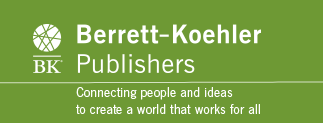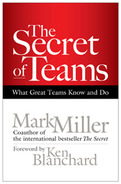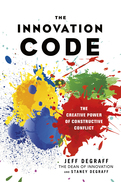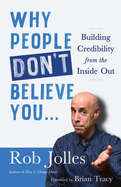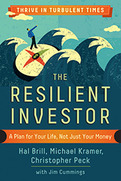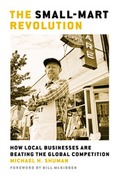Search Results: "building the future"
Results 79-84 of 1218
The Secret of Teams
2011
Teams are critical to the success of every organization. Departmental, interdepartmental, cross-functional, ad hoc, task-specific—teams do everything from planning the office party to setting the annual budget to establishing performance goals.
But what separates the teams that really deliver from the ones that simply spin their wheels? What is the secret of high-performance teams?
As he did in The Secret, Mark Miller uses a compelling business fable to reveal profound yet easily grasped truths that can dramatically transform any organization. Debbie Brewster, the heroine of The Secret, has been promoted and is now struggling with taking her new team to the next level. Her old mentor, Jeff Brown, the company's CEO, sends her out to find the secret of teams. On her journey she learns from three very different teams—the Special Forces, NASCAR, and a local restaurant.
Debbie and her team discover the three elements that all successful teams have in common. But that's just the beginning. The devil is in the details, as the story of Debbie's efforts to actually implement the three elements shows. You'll learn how to change entrenched ways of thinking and acting, what you have to do to optimize each of the three elements of a successful team, how to measure your progress, and more.
Creating high-performance teams does more than just give your organization a competitive advantage. It can be a performance multiplier that significantly improves results while honoring and developing people. It may be the ultimate win-win-win that your organization is seeking.
But what separates the teams that really deliver from the ones that simply spin their wheels? What is the secret of high-performance teams?
As he did in The Secret, Mark Miller uses a compelling business fable to reveal profound yet easily grasped truths that can dramatically transform any organization. Debbie Brewster, the heroine of The Secret, has been promoted and is now struggling with taking her new team to the next level. Her old mentor, Jeff Brown, the company's CEO, sends her out to find the secret of teams. On her journey she learns from three very different teams—the Special Forces, NASCAR, and a local restaurant.
Debbie and her team discover the three elements that all successful teams have in common. But that's just the beginning. The devil is in the details, as the story of Debbie's efforts to actually implement the three elements shows. You'll learn how to change entrenched ways of thinking and acting, what you have to do to optimize each of the three elements of a successful team, how to measure your progress, and more.
Creating high-performance teams does more than just give your organization a competitive advantage. It can be a performance multiplier that significantly improves results while honoring and developing people. It may be the ultimate win-win-win that your organization is seeking.
The Innovation Code
2017
The Innovation Code
The Creative Power of Constructive Conflict
Harmony is sublime in music but deadly to innovation. The only way to create new, hybrid solutions is to clash. Innovation happens when we bring people with contrasting perspectives and complementary areas of expertise together in one room. We innovate best with people who challenge us, not people who agree with us.
It sounds like a recipe for chaos and confusion. But in The Innovation Code, Jeff DeGraff, dubbed the “Dean of Innovation,” and Staney DeGraff introduce a simple framework to explain the ways different kinds of thinkers and leaders can create constructive conflict in any organization. This positive tension produces ingenious solutions that go far beyond “the best of both worlds.”
Drawing on their work with nearly half of the Fortune 500 companies, the DeGraffs help you harness the creative energy that arises from opposing viewpoints. They identify four contrasting styles of innovator—the Artist, the Engineer, the Athlete, and the Sage—and include exercises and assessments for building, managing, and embracing the dynamic discord of a team that contains all four. You can also figure out where you fit on the continuum of innovator archetypes.
Using vivid examples, The Innovation Code offers four steps to normalize conflict and channel it to develop something completely new. By following these simple steps, you will get breakthrough innovations that are both good for you and your customers. This is a rigorous but highly accessible guide for achieving breakthrough solutions by utilizing the full—and seemingly contradictory—spectrum of innovative thinking.
The Creative Power of Constructive Conflict
Harmony is sublime in music but deadly to innovation. The only way to create new, hybrid solutions is to clash. Innovation happens when we bring people with contrasting perspectives and complementary areas of expertise together in one room. We innovate best with people who challenge us, not people who agree with us.
It sounds like a recipe for chaos and confusion. But in The Innovation Code, Jeff DeGraff, dubbed the “Dean of Innovation,” and Staney DeGraff introduce a simple framework to explain the ways different kinds of thinkers and leaders can create constructive conflict in any organization. This positive tension produces ingenious solutions that go far beyond “the best of both worlds.”
Drawing on their work with nearly half of the Fortune 500 companies, the DeGraffs help you harness the creative energy that arises from opposing viewpoints. They identify four contrasting styles of innovator—the Artist, the Engineer, the Athlete, and the Sage—and include exercises and assessments for building, managing, and embracing the dynamic discord of a team that contains all four. You can also figure out where you fit on the continuum of innovator archetypes.
Using vivid examples, The Innovation Code offers four steps to normalize conflict and channel it to develop something completely new. By following these simple steps, you will get breakthrough innovations that are both good for you and your customers. This is a rigorous but highly accessible guide for achieving breakthrough solutions by utilizing the full—and seemingly contradictory—spectrum of innovative thinking.
Profit Building
2000
IMPROVING PROFIT is the number one objective of business leaders, yet most do not truly understand how to move beyond the basics when it comes to cost reduction for profit improvement. Typically, a company's response to reducing cost is to reduce the workforce. People are laid off in large numbers and dollars are saved-or so it seems. This is a mistake, a short-term solution. Profit Building provides a better approach, one that focuses on profit improvement as a stand-alone process, demonstrating how an organization can achieve its goals to improve profitability and reduce cost through a proven method based on team innovation management.
Perry J. Ludy offers a hands-on guide that shows managers how to move profit-and-loss financial reviews beyond the basics to creative solutions and genuine action plans. Using the author's four-step Profit Building Process (PBP), Profit Building shows how to organize teams with the specific purpose of improving profit-while providing an opportunity for employees to participate in developing cost reduction strategies so that profit improvement is perpetual.
A system of step-by-step activities designed to produce immediate and continuous results, the PBP shows managers how to apply concepts from prior learning-such as teams, innovation management, and performance improvement planning-to create tailor-made strategies for any organization. And it introduces "Questions Brainstorming," a new twist to traditional brainstorming that fosters avid group participation resulting in better solutions.
In order to achieve success beyond today, business leaders must leverage all resources available within the organization to improve profit, reduce cost, and create a better place to work. Profit Building is an executive handbook and a quick desk reference for managers that shows how to do just that.
Perry J. Ludy offers a hands-on guide that shows managers how to move profit-and-loss financial reviews beyond the basics to creative solutions and genuine action plans. Using the author's four-step Profit Building Process (PBP), Profit Building shows how to organize teams with the specific purpose of improving profit-while providing an opportunity for employees to participate in developing cost reduction strategies so that profit improvement is perpetual.
A system of step-by-step activities designed to produce immediate and continuous results, the PBP shows managers how to apply concepts from prior learning-such as teams, innovation management, and performance improvement planning-to create tailor-made strategies for any organization. And it introduces "Questions Brainstorming," a new twist to traditional brainstorming that fosters avid group participation resulting in better solutions.
In order to achieve success beyond today, business leaders must leverage all resources available within the organization to improve profit, reduce cost, and create a better place to work. Profit Building is an executive handbook and a quick desk reference for managers that shows how to do just that.
- An easy-to-read, how-to guide for executives, managers, business professionals, entrepreneurs, and change leaders who are seeking profit improvement strategies that fit their organizations
- By a working executive who has put these ideas into action and seen them work
- Provides a cost-reduction alternative to employee layoffs that also helps managers motivate employees to generate creative ideas
- Reveals how to immediately improve profits with over 100 innovative profit building ideas
For some, projecting confidence and credibility is second nature. For others, it seems like a foreign language they'll never learn – until now. Rob Jolles delivers down-to-earth solutions for anyone looking to enhance the most basic need of all; to be believed. He leverages his over 30 years of experience to equip readers with empowering and practical tools for achieving business and social success.
Jolles argues that credibility is as much about attitude as it is about aptitude. So-called “soft skills” like pitch, pace, and tone of voice, are actually some of the most crucial factors in determining how people perceive us. As he puts it, “it's not the words, it's the tune” that really makes us memorable and credible.
This book is about finding the necessary magic to help others believe you. It requires an unshakable belief in yourself, so Jolles starts there. With that as a solid foundation, you can move on to the specific tactics and practices that will make you credible and convincing. But these can be tough to practice in the face of the inevitable setbacks we all face, so he also offers advice on maintaining courage and confidence when doubt naturally creeps in. And he concludes with a discussion of sustaining your newfound credibility for the long haul.
There isn't a soul on earth who hasn't questioned themselves at some point. And most of us are just one or two brutal rejections away from questioning all that we are. Why People Don't Believe You helps readers cultivate a robust mental framework and a set of what Jolles calls “performance skills” to tackle these doubts. You are good enough –and after reading this stirring book, you'll be ready to make the world believe that as well.
Jolles argues that credibility is as much about attitude as it is about aptitude. So-called “soft skills” like pitch, pace, and tone of voice, are actually some of the most crucial factors in determining how people perceive us. As he puts it, “it's not the words, it's the tune” that really makes us memorable and credible.
This book is about finding the necessary magic to help others believe you. It requires an unshakable belief in yourself, so Jolles starts there. With that as a solid foundation, you can move on to the specific tactics and practices that will make you credible and convincing. But these can be tough to practice in the face of the inevitable setbacks we all face, so he also offers advice on maintaining courage and confidence when doubt naturally creeps in. And he concludes with a discussion of sustaining your newfound credibility for the long haul.
There isn't a soul on earth who hasn't questioned themselves at some point. And most of us are just one or two brutal rejections away from questioning all that we are. Why People Don't Believe You helps readers cultivate a robust mental framework and a set of what Jolles calls “performance skills” to tackle these doubts. You are good enough –and after reading this stirring book, you'll be ready to make the world believe that as well.
If you want to build a better life and a better world—and really be prepared for any possible future in these turbulent times—you need to become a resilient investor! This trailblazing guide will expand your ideas of investing way beyond Wall Street. Your time, your energy, and the things you own are investments too, and you'll learn to diversify them in ways that move you toward your life goals.
The Resilient Investment Map lays out all your assets—personal and physical as well as financial—and then provides three essential, timely strategies (Close to Home, Sustainable Global Economy, and Evolutionary Investing) that will help you grow each of them. The goal is to become more resilient: able to anticipate disturbance, rebuild as necessary, and improve when possible. You'll discover that the choices making you more resilient also enhance our communities, our economy, and the planet—building real wealth for all.
The Resilient Investment Map lays out all your assets—personal and physical as well as financial—and then provides three essential, timely strategies (Close to Home, Sustainable Global Economy, and Evolutionary Investing) that will help you grow each of them. The goal is to become more resilient: able to anticipate disturbance, rebuild as necessary, and improve when possible. You'll discover that the choices making you more resilient also enhance our communities, our economy, and the planet—building real wealth for all.
Defenders of massive multinational chains like Wal-Mart and Fortune 500 big business argue that, like it or not, there is no alternative. Their huge scale and international reach, they claim, make them more efficient and profitable, better able to deliver value, and an uncontested boon for the job market. According to the big boys, locally owned small businesses are simply quaint remnants of the past, unable to compete in the global economy.
But in The Small-Mart Revolution, Michael Shuman shows that the benefits these mega-stores and huge corporations supposedly deliver to communities are illusory. Crunch the numbers and you'll find that locally owned businesses turn out to be much more reliable generators of good jobs, economic growth, tax dollars, community wealth, charitable contributions, social stability, and political participation. Unlike their global competitors, they do this without massive tax breaks and subsidies that often put local economies in a permanent hole. Plus, contrary to popular belief, local businesses are competitive with the multinationals--and gaining ground every day. Shuman highlights numerous trends that are making the old "bigger is better" economies of scale argument obsolete, and he describes a variety of innovative strategies these businesses are using to successfully compete with their over-sized competitors. He also shows how consumers, investors, and policymakers can support their own communities by "going local." The Small-Mart Revolution offers a robust alternative to "go-go" globalization, one that nurtures the creative capacities of local businesses and enables communities everywhere to thrive.
But in The Small-Mart Revolution, Michael Shuman shows that the benefits these mega-stores and huge corporations supposedly deliver to communities are illusory. Crunch the numbers and you'll find that locally owned businesses turn out to be much more reliable generators of good jobs, economic growth, tax dollars, community wealth, charitable contributions, social stability, and political participation. Unlike their global competitors, they do this without massive tax breaks and subsidies that often put local economies in a permanent hole. Plus, contrary to popular belief, local businesses are competitive with the multinationals--and gaining ground every day. Shuman highlights numerous trends that are making the old "bigger is better" economies of scale argument obsolete, and he describes a variety of innovative strategies these businesses are using to successfully compete with their over-sized competitors. He also shows how consumers, investors, and policymakers can support their own communities by "going local." The Small-Mart Revolution offers a robust alternative to "go-go" globalization, one that nurtures the creative capacities of local businesses and enables communities everywhere to thrive.
- Shows exactly why locally owned businesses are far more beneficial to their communities than massive chains like Wal-Mart
- Outlines specific strategies small and home-based businesses are using to successfully outcompete the world's largest companies
- Advises consumers, investors, policymakers, and organizers on how they can support the the local entrepreneurs who contribute to their communities
